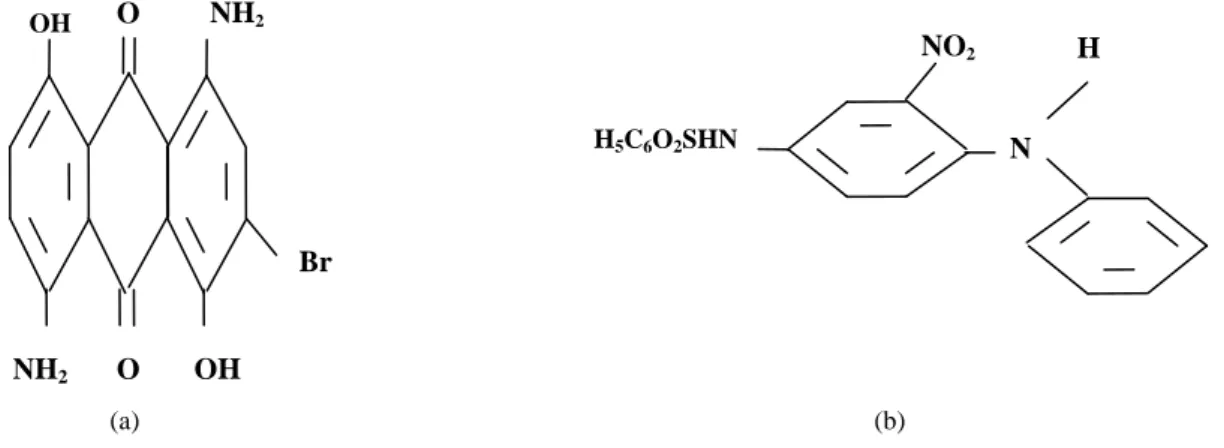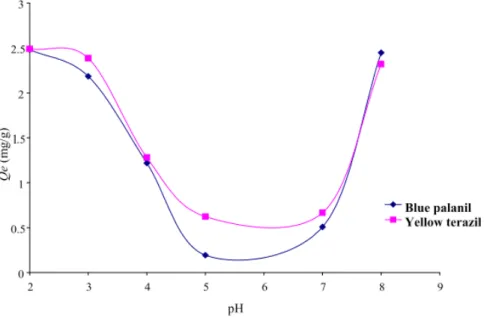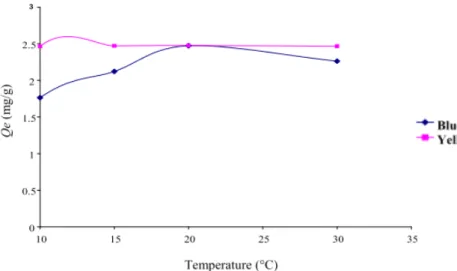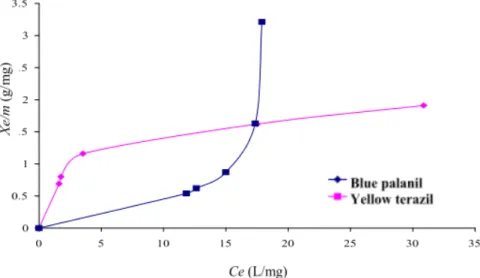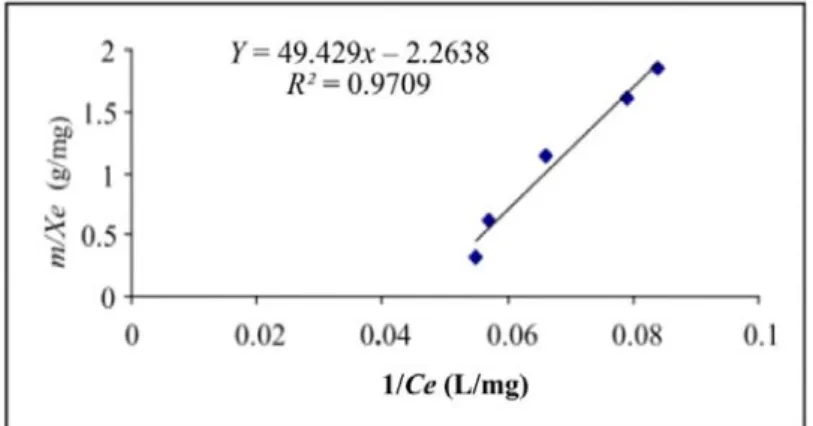See discussions, stats, and author profiles for this publication at: https://www.researchgate.net/publication/265086434
Removal of Dispersed Dyes from Aqueous Solution Using Activated Carbon
Prepared from Olive Stones
Article in Journal of Agricultural Science and Technology · May 2014
CITATIONS
5
READS
1,108
4 authors, including:
Some of the authors of this publication are also working on these related projects: Call for papers for Process Engineering Journal: Third IssueView project
textil dyesView project Sabrina Hemsas
University M'Hamed Bougara of Boumerdes
2PUBLICATIONS 5CITATIONS SEE PROFILE Hakim Lounici Université de Bouira 202PUBLICATIONS 3,560CITATIONS SEE PROFILE
All content following this page was uploaded by Hakim Lounici on 27 August 2014.
Journal of Agricultural Science and Technology A 4 (2014) 414-421
Earlier title: Journal of Agricultural Science and Technology, ISSN 1939-1250
Removal of Dispersed Dyes from Aqueous Solution
Using Activated Carbon Prepared from Olive Stones
Sabrina Hemsas1, Hakim Lounici2, Zohra Belkebi1 and Khaled Benrachedi11. Laboratory of Alimentary Technology, Faculty of Engineering Sciences, University of Boumerdes, Boumerdes 35000, Algeria 2. Laboratory BIOGEP, Polytechnique Institute, Alger 16000, Algeria
Received: January 23, 2014 / Published: May 20, 2014.
Abstract: In order to valorize olive stones and to show its potential use in the sorption of two dispersed dyes, it was transformed in
activate carbon and characterized. The effects of different system variables: pH, agitation speed, temperature and initial dye concentration were studied in the batch tests. The adsorption capacity of activated carbon for the dyes removal was found to be affected by the solution’s pH. Acidic pH was found the favour disperse dyes removal. Over 95% removal was achieved for both the dyes at pH 3. The equilibrium time for both dyes was 30 min. Both Langmuir and Freundlich isotherms could be used to describe the adsorption of the dyes. Freundlich adsorption model succeeded in fitting the adsorption isotherms of dyes on olive stones activated carbon in single-solute systems, and prediction of the competitive adsorption behavior of dyes with the Freundlich-based Sheindorf-Rebuhn-Sheintuch (SRS) model gave acceptable results.
Key words: Adsorption, dye, olive stones, activated carbon, multiadsorption.
1. Introduction
Wastes from the textile industry are enormous harm to human health, especially the different colors that are used in excess. As a result, wastewater is highly concentrated in colors which make biological treatment difficult to apply because of their low biodegradability. In this context, several processes have been used, such as the coagulation-flocculation [1], activated carbon adsorption and most recently elect coagulation [2] which have proved effective, however remain very expensive. The research was then oriented processes using natural materials (sawdust, agricultural waste, activated carbon, ect.) and some industrial waste because of their availability and low costs [3, 4].
The origin of our work is the valorization of olive stones in treatment of colored effluents. The olive
Corresponding author: Sabrina Hemsas, Ph.D., research
fields: environmental sciences, water treatment and material valorization. E-mail: hemsas_sab@yahoo.fr.
stones are a byproduct of olive cultivation, rejected in large quantities in nature.
This type of waste has all characteristics suitable to have high adsorption capacity toward organic materials after chemical and thermal treatment [5].
This work aims to study the adsorption batch of two disperse dyes (blue palanil and yellow terazil), two dyes know to be very refractive to conventional treatment. To do this conducted an experimental study of the adsorption kinetic, by studying the effect of major parameters on the adsorption capacity. Given heterogeneity of the composition of wastewater from the textile industry, we have determined the simple and modified isotherms on multiadsorption for the mixture of the two dyes studied.
2. Materials and Methods
2.1 Materials
Classification of dyes is based on the chemical and technological data. The chemical classification is
DAVID PUBLISHING
D
Removal of Dispersed Dyes from Aqueous Solution Using Activated Carbon Prepared from Olive Stones 415
based on molecular structure, in particular on the nature of the active groups involved. In dying, the treatment factors conditioning the choice of colors and their type of classification, than the disperse dyes, according to the technologic classification are suitable for low polar fiber, i.e., fiber with functional groups are not hydrolysable. They are characterized by slow kinetics of dying process, which requires operating at high temperature and under pressure [6]. The two tested dyes belong to this large family cited. These are the blue palanil disperse R-disperse blue 56cl 63285 and yellow disperse GWL 01. The formulas of these dyes are shown in Fig. 1 and the main characteristics of the prepared activated carbon are presented in Table 1.
2.2 Methods
The solutions of the dyes used are prepared taking into account their solubility. For all compounds studied, we have used their same method, consisting in preparing first, a stock solution, from which we prepare successive dilutions, a series of solutions of concentration well defined at the same pH. The analytical method was used in the UV visible spectrophotometer. A study of their spectra of UV-visible wavelengths between 200 nm and 700 nm, mode using a spectrophotometer type JASCO V-530, has determined the wavelengths corresponding to adsorption maxima, λmax are λ1 = 536 nm and λ2 = 437
nm for the colors blue palanil and yellow terazil, respectively and we established the calibration curve at wavelength corresponding to maximum absorption of the dye. Following Eq. (1):
0
ln /
I I
k lc
(1)where, kλ is a constant depending only on the wavelength and nature of the solution. The absorption of the solution is given by the relationship:
0
ln
/
Ab
I I
lc
(2)According the low of Lambert-Beer, the absorbance of the mixture is given by the following equations: 1 1 1 1
:
(
)
(
)
(
)
(
)
b r rAt
A
BP C BP l
JT C JT l
(3) 2 2 2 2:
(
)
(
)
(
)
(
)
b r rAt
A
BP C BP l
JT C JT
(4)where, ελ is the molar extinction coefficient of dye at the wavelength ελ (L/molcm), l is the optical path (cm), Cr (L/mol).
The experiments we conducted using a jar-test (Velp-scientifica) for each dye (blue palanil and yellow Terazil). It deals with identical volumes (10 mL) of 50 mg/L dye solutions, except for experiments in which the effect of initial concentration of dye was studied, with 2 g of activated carbon. The mixture is stirred for 2 h at room temperature with stirring speed of 50 rpm, the samples are collected pre-determined time intervals, are filtered then the absorbance are measured. The quantity (Qe) of dye adsorbed at equilibrium is given in Fig. 1:
(a) (b)
Fig. 1 Formulas of disperse dyes: (a) blue palanil and (b) yellow terazil.
N H NO2 H5C6O2SHN NH2 NH2 OH Br O OH O
Table 1 Used activated carbon properties.
Characteristics Mean value
Humidity (%) 4 Ash (%) 13 pH at 20 °C 8.42 Specific surface (m2/g) 635 Pore volume (mL/g) 0.62 Iodine index (mg/g) 810.26 Phenol index (mg/L) 30.48 0
(
)
/
e rQ
C
C V m
(5) where, C0 and Cr are the initial and equilibrium statedye concentration (mg/L), V is the volume (L) and m is the mass of the adsorbent used (g). The effect of pH was studied adjusting the pH of dye solutions using 1 N HCl or 1 N NaOH.
The study of the influence of temperature was conducted by immersing solution in a thermostatic bath regulated at work temperature.
3. Results and Discussion
3.1 Influence of pH on the Dyes Adsorption
The pH plays an important role in the adsorption process, particularly on the adsorption capacity. Fig. 2 shows the effect of pH on the adsorption of two disperse dyes studied. It is observed that adsorption
capacity obtained for both dyes is maximum at pH = 2 and a pH increase from 2 to 5, when the pH increasing from 2 to 5, that decrease substantially the adsorption capacity, showing acidic pH is favorable for the dispersed dyes adsorption. These results corroborate the work of Ozokar and Sengil [6], the optimum pH for dispersed dyes adsorption is also an acidic pH.
In the acidic conditions, the positive charge dominates the surface of the adsorbent. Thus, a significantly high electrostatic attraction exists between the positive charges of the surface of the adsorbent and the negative charges of the dye [7, 8].
At alkaline pH despite the presence of OH- ions, showing that the capacity is higher compared to neutral pH (5, 6 and 7), so we could say that there is always an attraction between the dyes and the adsorbent and it is not competition between the OH- ions and the anions of dyes at basic pH.
3.2 Effect of Stirring Time and Speed
The speed was varied from 20-200 rpm. The results in Fig. 3 shows that increasing the stirring speed to 50 rpm, increased the adsorption capacity decreases slightly. We considered that there is an optimal stirring speed sufficient to promote contact between
Removal of Dispersed Dyes from Aqueous Solution Using Activated Carbon Prepared from Olive Stones 417
the particles of activated carbon and dye molecules sufficiently low to can break the adsorption forces.
3.3 Effect of Temperature
It is noted in Fig. 4 that the increase of temperature from 15 °C to 20 °C induces an increase of the adsorption capacity and a decrease of the adsorption capacity oven 20 °C. The rises of temperature from 20 °C have the effect of destabilizing the acting physical forces. The effect of temperature is more evident for the blue palanil dye.
3.4 Influence of Initial Concentration of Dyes
It is noted in Fig. 5 that the dyes adsorption capacities by activated carbon increase with
increasing initial concentrations. Increasing concentration induces elevation of strength training on the gradient of concentration, therefore increasing the diffusion of dye molecules in the surface of the adsorbent [7].
3.5 Modeling of Isothermal Adsorption
3.5.1 Simple Adsorption Isotherms
Two commonly used isotherms, i.e., Langmuir and Freundlich, were tested. The Langmuir isotherm and its linear form are represented by the following equations:
Qe = bQ0Ce/1 + bCe (6)
1/Qe = [1/bQ0] 1/Ce + 1/Q0 (7)
where, Qe is the amount of adsorbate adsorbed per
Fig. 3 Effect of stirring time and speed on dyes removal (pH = 3, C0 = 50 mg/L, m = 2 g, T = 20 °C).
Fig. 5 Effect of initial dyes concentration on dyes removal (m = 2 g, pH = 3, T = 20 °C, 50 rpm).
Fig. 6 Isotherms adsorption of the two dyes studied (pH = 3, C0 = 50 mg/L, T = 20 °C, 50 rpm).
unit weight of adsorbent (mg/g), Q0 denotes the
adsorption capacity (mg/g), b indicates the energy of
adsorption (L/mg) and Ce is the equilibrium
concentration of adsorbate in solution (mg/L).
The Freundlich isotherm and its linear form are represented by Eqs. (8) and (9).
1/ n e e
Q
K C
(8)1
ln
Q
eln
K
ln
C
en
(9)where, K is the Freundlich capacity factor and 1/n is the Freundlich intensity parameter. We have established simple isotherms adsorption on activated
carbon for the two dyes in Fig. 6. The results show that for yellow terazil isotherm is of type L and the blue palanil isotherm is S type, both Langmuir and Freundlich could be used to describe the adsorption of the dye.
Plots of linear forms of Langluir and Freundlich equations for the two disperse dyes yielded coefficients as shown in Table 2. Both the Langmuir and Freundlich isotherms were found to fit well to the experimental data with the former being slightly better as indicated by the higher R2 values. The applicability of these isotherms suggests monolayer coverage of the dye on the surface of the activated carbon.
Removal of Dispersed Dyes from Aqueous Solution Using Activated Carbon Prepared from Olive Stones 419
The Langmuir and Freundlich expression for disperse blue palanil and disperse yellow terazil removal by activated carbon can be represented as below:
Langmuir equation (Figs. 7 and 8): Disperse yellow terazil:
Qe = 0.696 Ce/1 + 0.343 Ce (10)
Disperse blue palanil:
Qe = 0.0198 Ce/1 + 0.045 Ce (11)
Freundlich equation (Figs. 9 and 10): Disperse yellow terazil:
Qe = 0.669 Ce0.31 (12)
Disperse blue palanil:
Qe = 4.51 10-5 Ce3.75 (13)
3.5.2 Modified Freundlich Isotherms
The Freundlich equation from m competitive species as follow: , 1 1
(
)
m ni i i i i j j jQ
K C
a c
(14)where, Qi is the adsorption capacity for each
component i; Ci and Cj are the concentrations of i and j in the equilibrated solution, ni and ki are the
Freundlich constants obtained for i in a single-component I in the presence of component j, for binary, the isotherm can be written as:
12 1 1 2 2 21 2 2 1 1
and
C
C
a
a
C
C
C
C
(15) 1 2 1 1 1 1 1 2 2 1 1 2 1 2(
K C
)
nand
(
K C
)
n(16)
q
q
If both concentrations vary during the experiment, plotting C1/C2 vs β1/C2 yield at straight line with a slope of unity and the competition coefficient is determined from the intercept.
According to Figs. 11 and 12, a12 and a21 have been determined.
a12 is the competition coefficient of blue palanil in the presence of yellow terazil.
a21 is the competition coefficient of yellow terazil in the presence of blue palanil.
Fig. 7 Langmuir isotherm for yellow terazil adsorption on activated carbon.
Fig. 8 Langmuir isotherm for blue palanil dye adsorption on activated carbon.
m /X e (g /mg )
Fig. 9 Adsorption Freundlich isotherm for yellow terazil adsorption on activated carbon.
Fig. 10 Adsorption Freundlich isotherm for blue palanil on activated carbon.
Fig. 11 Modified Freundlich isotherm for adsorption of the mixture of two dyes (determination of competition coefficient a12).
Fig. 12 Modified Freundlich isotherm for adsorption of the mixture of two dyes (determination of competition coefficient a21). C1 /C 2 ln Xe /m ln Xe /m lnCe lnCe B1/C2 B2/C1 C1 /C 2
Removal of Dispersed Dyes from Aqueous Solution Using Activated Carbon Prepared from Olive Stones 421
Table 2 Modeling adsorption parameters.
Dye Langmuir isotherm coefficients Freundlich isotherm coefficients
Q0 (mg/g) b R2 K 1/n R2
Disperse yellow terazil Disperse blue palanil
2.03 -0.44 0.343 -0.045 0.9858 0.9709 0.3125 4.51·10-5 0.3125 3.75 0.9508 0.8769 Competition coefficients estimated from the fitting
results summarized in Table 2 give information of relative adsorption capability of each species in the binary-solute systems. The a12 value, corresponding to the selectivity to solute 1 (blue palanil) in the presence of solute 2 (yellow terazil), are higher than a21, indicating the affinity of blue palanil to the adsorbent.
Based on these results, we can say that the blue palanil has more affinity with the adsorbent then the yellow terazil. We obtain finally the modified Freundlich equation for the two dyes.
For the blue palanil dye:
-5 -0.734
1 4.51 10 1 (1.16 0.72 2 1) (17)
Q C C C
For yellow terazil dye:
2.2
2
0.669
2(1.16
20.72
1) (18)
Q
C
C
C
4. Conclusions
The olive stones are until now considered as waste, but they can be valorized through the establishment of activation protocol to obtain activated carbon used in the treatment of colored effluents. Through the study of the batch adsorption system, we found that in acidic pH, we obtain an optimal adsorption under agitation speed of 50 rpm and temperature value of 20 °C. The SRS model is the convenient model for the prediction of competitive adsorption behavior in multi-solute
systems if the adsorption of the corresponding single-solute system obeys the Freundlich equation.
References
[1] S. Kacha, M.S. Ouali, S. Elmalah, Removal of wastewater dyes from textile industry by bentonite and aluminum salts, Rev. Sci. Eau. 2 (1997) 233-248. (in French)
[2] S. Suhee, Combined performance of electro coagulation and magnetic separation process for treatment of dye wastwater, Korean J. Chem. Eng. 4 (2004) 806-810. [3] S. Tahiri, Removal of dyes from aqueous solutions by
adsorption on chrome-tanned solid wastes generated in the leather industry, Water Qual. Res. 38 (2003) 393-411.
[4] K. Benrachdi, A. Mekarzia, Study of the phenol adsorption on the coffee turned into powdered activated carbon, J. Soc. Alger. Chem. 11 (2001) 25-35.
[5] H. Gharib, A. Ouderni, Chemically transformation of Tunisian olive in activated carbon by phosphoric acid, Recent Progress in CG 50 (2005) 10-15. (in French) [6] M. Ozacar, I.A. Sengil, Application of kinetic models to
the sorption of disperses dyes onto alunite, colloids and surfaces, Physicochem. Aspects 242 (2004) 105-113. [7] M.H. Isa, Low cost removal of disperse dyes from
aqueous solutions using palm ash, Dues and Pigments 74 (2) (2007) 446-453.
[8] Y.Q. Yan, L. Qian, G.B. Yu, W. Yan, Kinetics of adsorption of dispersed dyes by poly-epi-choloro-hydrin-dinmethylamine cationic polymer/bentonite, Separation and Purification Technology 50 (2006) 1-12.
View publication stats View publication stats
